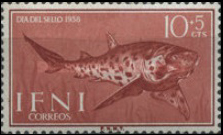Scyliorhinus stellaris Linnaeus, 1758

(Da: www.anderssalesjo.com)
Phylum: Chordata Haeckel, 1874
Subphylum: Vertebrata Lamarck J-B., 1801
Classe: Chondrichthyes Huxley, 1880
Ordine: Carcharhiniformes Compagno, 1977
Famiglia: Scyliorhinidae Gill, 1862
Genere: Scyliorhinus Blainville, 1816
Italiano: Gattopardo
English: Nursehound
Français: Grande roussette, Roussette à grandes tâches, Chat-rochier
Deutsch: Großgefleckter Katzenhai
Español: Alitán
Descrizione
Presenta un corpo molto allungato, di forma quasi cilindrica, piuttosto compresso sul dorso. Gli occhi sono sporgenti e posti verso la parte alta del capo. Il muso è appuntito. Le due pinne dorsali sono molto arretrate sul dorso, le pettorali sono ampie, le ventrali più piccole, così come la pinna anale. La coda presenta il lobo superiore più sviluppato di quello inferiore. La livrea si presenta con un colore di fondo variabile dal grigio al beige (con ventre bianco), maculato da chiazze marroni. Raggiunge una lunghezza di 170 cm. La fecondazione è interna: la femmina depone poi alcuni astucci ovarici (ciascuno generata da un ovidotto diverso) dalla forma particolare, conosciuti comunemente come borsellino della sirena, che fissa a rocce, coralli o alghe. La crescita dell'embrione avviene in questi astucci e alla schiusa il piccolo misura già 16 cm. Si ciba di crostacei e altri invertebrati che caccia setacciando il fondale, e di piccoli squali, tra cui Scyliorhinus canicula.
Diffusione
Questo squalo è diffuso nel Mediterraneo centro-occidentale (Mar Egeo, Mar Adriatico, e dal Tirreno allo Stretto di Gibilterra), nonché nelle acque costiere dell'Oceano Atlantico orientale, dalla Guinea fino al Mare del Nord sulle coste scandinave. Abita fondali rocciosi, foreste di alghe e zone coralline, mantenendosi tra 2 e 125 metri di profondità.
Sinonimi
= Scyllium acanthonotum De Filippi, 1857 = Scyllium catulus Müller & Henle, 1838 = Squalus stellaris Linnaeus, 1758.
Bibliografia
–Finucci, B.; Derrick, D.; Pacoureau, N. (2021). "Scyliorhinus stellaris". IUCN Red List of Threatened Species. 2021.
–Compagno, L.J.V. (1984). Sharks of the World: An Annotated and Illustrated Catalogue of Shark Species Known to Date. Rome: Food and Agricultural Organization. Pp. 366-367.
–Squalus stellaris[permanent dead link]. (2007). Catalog of Fishes. California Academy of Sciences.
–Davidson, A. (2002). Mediterranean Seafood: A Comprehensive Guide with Recipes (third ed.). Ten Speed Press. P. 28.
–Compagno, L.J.V.; Dando, M. & Fowler, S. (2005). Sharks of the World. Princeton University Press. P. 252.
–Lythgoe, J. & Lythgoe, G. (1992). Fishes of the Sea: The North Atlantic and Mediterranean. MIT Press. P. 21.
–Soldo, A.; Dulcic, J. & Cetinic, P. (2000). "Contribution to the study of the morphology of the teeth of the nursehound Scyliorhinus stellaris (Chondrichthyes: Scyliorhinidae)". Scientia Marina. 64 (3): 355-356.
–Sims, D.W.; Southall, E.J.; Wearmouth, V.J.; Hutchinson, N.; Budd, G.C. & Morritt, D. (2005). "Refuging behaviour in the nursehound Scyliorhinus stellaris (Chondrichthyes: Elasmobranchii): preliminary evidence from acoustic telemetry". Journal of the Marine Biological Association of the United Kingdom. 85 (5): 1137-1140.
–Scott, G.W.; Gibbs, K. & Holding, J. (1997). "Group 'resting' behaviour in a population of captive bull huss (Scyliorhinus stellaris)". Aquarium Sciences and Conservation. 1 (4): 251-254.
–Ford, E. (1921). "A contribution to our knowledge of the life-histories of the dogfishes landed at Plymouth" (PDF). Journal of the Marine Biological Association of the United Kingdom. 12 (3): 468-505.
–Kearn, G.C. (2004). Leeches, Lice and Lampreys: A Natural History of Skin and Gill Parasites of Fishes. Springer. P. 104.
–Llewellyn, J.; Green, J.E. & Kearn, G.C. (1984). "A check-list of monogenean (Platyhelminth) parasites of Plymouth hosts". Journal of the Marine Biological Association of the United Kingdom. 64 (4): 881-887.
–Williams, H.H. & Jones, A. (1994). Parasitic Worms of Fish. CRC Press. P. 336.
–Pulsford, A. (1983). "Preliminary studies on trypanospmes from the dogfish, Scyliorhinus canicula L". Journal of Fish Biology. 24 (6): 671-682.
–Ramdane, Z.; Bensouilah, M.A. & Trilles, J.P. (2007). "The Cymothoidae (Crustacea, Isopoda), parasites on marine fishes, from Algerian fauna". Belgian Journal of Zoology. 137 (1): 67-74.

|
Data: 23/11/1958
Emissione: Gioranata del francobollo - Ittiofauna e barche Stato: Ifni Nota: Emesso in una serie di 3 v. diversi |
|---|